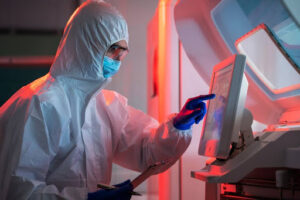Breaking Barriers In Sarcoma Detection: New Frontiers In Testing

Advancements in technology and medical research are revolutionizing how Sarcoma, a rare form of cancer, is detected and diagnosed. With approximately 50 complex subtypes, sarcoma requires precise and timely detection for effective treatment. This article explores cutting-edge techniques and breakthroughs that have broken barriers in sarcoma detection.
Challenges In Sarcoma Detection
With its numerous subtypes, sarcoma presents a significant challenge for clinicians regarding accurate and timely detection. Traditional methods of sarcoma detection have proven challenging due to the similarities between sarcoma and other benign conditions. This often leads to misdiagnosis and delays in appropriate treatment, impacting patient outcomes.
Traditional Testing Methods
Historically, sarcoma detection relied on imaging techniques and tissue biopsies. While helpful, these methods need to be improved in accuracy and reliability. Medical imaging techniques have revolutionized the diagnosis and treatment of various medical conditions. The most commonly used imaging techniques include X-rays, CT scans, and MRIs. X-rays use a small amount of computed tomography (CT), a medical imaging technology that uses X-rays and radiation to produce detailed images of bones and internal structures. During a CT scan, X-ray images are taken from multiple angles and combined to create a cross-sectional view of the body’s interior.
This technology is commonly used to diagnose and monitor various medical conditions, including cancer, heart disease, injuries to internal organs, and detailed 3D images of the body. MRI, conversely, uses a strong magnetic field and radio waves to create images of soft tissues and organs. These imaging techniques help doctors identify and diagnose various medical conditions accurately and precisely. Scans provided valuable insights into the presence and location of tumors. However, they needed more specificity in differentiating between Sarcoma and other conditions. Tissue biopsies, although more definitive, were invasive and often required surgical intervention.
Limitations Of Traditional Testing Methods
One of the primary limitations of traditional testing methods for sarcoma detection is the difficulty in distinguishing Sarcoma from other benign conditions. The shared characteristics and overlapping symptoms make diagnosis challenging, leading to delays in appropriate treatment. Moreover, although considered the gold standard, tissue biopsies can be invasive and may only sometimes provide sufficient tissue for accurate diagnosis.
New Frontiers In Sarcoma Testing
Recent genetic and molecular testing advancements have opened up new frontiers in sarcoma detection. These innovative techniques and the integration of artificial intelligence enable clinicians to identify specific sarcoma subtypes and determine the most effective treatment approaches.
Liquid Biopsies: A Game-Changer In Sarcoma Detection
Liquid biopsies represent a transformative breakthrough in sarcoma detection, offering a non-invasive and cost-effective avenue for early diagnosis and monitoring. These tests unveil crucial insights into sarcoma-specific genetic mutations and alterations by analyzing circulating tumor DNA fragments in the blood. Among these innovative options, the OncoCount test by RGCC-North America stands out, tracking circulating tumor cells (CTCs) and evaluating treatment effectiveness. By measuring CTC concentration, OncoCount enables healthcare providers to gauge treatment response and detect sarcoma recurrence.
The OncoCount test serves as a vital tool in interim monitoring, enabling clinicians to assess treatment efficacy and identify cancer recurrence. Patients can anticipate a straightforward process, as the test entails a non-invasive liquid biopsy using a blood sample. Once collected, the sample is sent to RGCC’s state-of-the-art laboratory in Greece for analysis. Results are then relayed to the accredited practitioner, who arranges a consultation to discuss findings and devise a personalized treatment plan.
RGCC’s commitment to cutting-edge cancer care extends to sarcoma patients, with the OncoCount test offering comprehensive insights into tumor biology and treatment response. By harnessing advanced technology and innovative techniques, RGCC empowers patients and healthcare professionals to navigate the sarcoma journey. With a focus on personalized care plans and early detection, RGCC strives to enhance outcomes and enrich the quality of life for individuals battling sarcoma.
Advancements In Imaging Techniques For Sarcoma Diagnosis
Advancements in imaging techniques have also contributed to improved sarcoma detection. Positron emission tomography (PET) scans are a medical imaging test that uses a special dye containing radioactive tracers to produce detailed 3D images of the inside of the body. PET scans can help detect and diagnose various conditions, including cancer, heart disease, and brain disorders, by showing how organs and tissues function at a cellular level. These scans are often used with other imaging tests, like CT or MRI, to provide a comprehensive view of a patient’s health. Promise in differentiating between benign and malignant tumors. Using a radioactive tracer, PET scans can detect metabolic changes associated with Sarcoma, providing valuable information for accurate diagnosis and staging.
Molecular Testing: Unraveling The Genetic Profile Of Sarcoma
Molecular testing has emerged as a powerful tool in sarcoma detection. Clinicians can better understand the underlying biology and identify potential therapeutic targets by analyzing sarcoma tumors’ genetic and molecular characteristics. Techniques such as next-generation sequencing (NGS) and polymerase chain reaction (PCR) have significantly advanced our ability to identify specific genetic alterations and mutations associated with sarcoma subtypes.
The Role Of Artificial Intelligence In Sarcoma Testing
Artificial intelligence (AI) is increasingly essential in sarcoma detection. Machine learning algorithms can analyze vast amounts of data, including imaging scans and genetic profiles, to identify patterns and predict outcomes. By leveraging AI, clinicians can make more accurate and personalized treatment decisions, improving patient outcomes in sarcoma management.
Conclusion: The Future Of Sarcoma Detection
As the field of sarcoma detection continues to evolve, these advancements bring hope for improved outcomes and a brighter future for patients battling this rare form of cancer. The integration of genetic and molecular testing, innovative imaging techniques, and the utilization of artificial intelligence is revolutionizing how we detect and diagnose Sarcoma. By breaking barriers in sarcoma detection, we can provide earlier interventions and personalized treatment approaches and ultimately improve the lives of those affected by this challenging disease.








